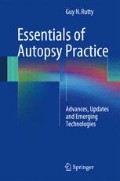Abstract
This chapter presents a personal approach to the investigation of a dismembered body, exampled by the investigation of a dismembered limb from a homicide. It first presents an overview of the number of dismemberments encountered each year in England and Wales, the anatomical site at which the dismemberment is usually achieved, and common sites of disposal. It then presents an overview from a pathological viewpoint of an approach from scene to mortuary in considering the four standard questions of who the person was, where, when, and by what means they came by their death. By taking such an approach, it demonstrates how much information can be gained for the investigating police force by the examination of just a limb. The second part of the chapter then considers from an engineering viewpoint the instruments that may have been used to dismember the body and which methods can be used to identify the said instrument. Thus the chapter provides an overall approach to the investigation of a dismembered body.
Access this chapter
Tax calculation will be finalised at checkout
Purchases are for personal use only
Notes
References
Reichs KJ. Postmortem dismemberment: recovery, analysis and interpretation. In: Reichs KJ, editor. Forensic osteology – advances in the identification of human remains. Springfield: Charles C Thomas; 1998. p. 353–88.
Symes SA. Suitcase man: the investigation, forensic analysis and prosecution of a homicide with postmortem dismemberment. In: Proc 60th Ann Meeting of the American Academy of Forensic Sciences, 14. Washington, DC/Colorado Springs: American Academy of Forensic Sciences; 2008. p. 22.
Randall B. Blood and tissue spatter associated with chainsaw dismemberment. J Forensic Sci. 2009;54:1310–4.
Dogan KH, Demirci S, Deniz I, Erkol Z. Decapitation and dismemberment of the corpse: a matricide case. J Forensic Sci. 2010;55:542–5.
Racette R, Tho Vo T, Sauvageau A. Suicidal decapitation using a tractor loader: case report and review of the literature. J Forensic Sci. 2007;52:192–4.
Byard RW, Gilbert JD. Characteristic features of deaths due to decapitation. Am J Forensic Med Pathol. 2004;25:129–30.
Tsokos M, Turk EE, Uchigasaki S, Puschel K. Pathologic features of suicidal complete decapitations. Forensic Sci Int. 2004;139:95–102.
Morild I, Lilleng PK. Different mechanisms of decapitation: three classic and one unique case history. J Forensic Sci. 2012;57(6):1659–64.
Brough AL, Rutty GN, Black S, Morgan B. Post-mortem computed tomography and 3D imaging: anthropological applications for juvenile remains. Forensic Sci Med Pathol. 2012;8(3):270–92.
Rutty GN, Robinson C, Morgan B, Black S, Adams C, Webster P. Fimag: the United Kingdom disaster victim/forensic identification imaging system. J Forensic Sci. 2009;54(6):1438–42.
Robinson C, Eisma R, Morgan B, Jeffery A, Graham EA, Black S, Rutty GN. Anthropological measurement of lower limb and foot bones using multi-detector computed tomography. J Forensic Sci. 2008;53(6):1289–95.
Fraser I, Meier-Augenstein W. Stable (2)H isotope analysis of modern-day human hair and nails can aid forensic human identification. Rapid Commun Mass Spectrom. 2007;21(20):3279–85.
Westen AA, Gerretsen RR, Maat GJ. Femur, rib, and tooth sample collection for DNA analysis in disaster victim identification (DVI): a method to minimize contamination risk. Forensic Sci Med Pathol. 2008;4(1):15–21.
Zinka B, Kandlbinder R, Schupfner R, Haas G, Wolfbeis OS, Graw M. The activity ratio of 228Th to 228Ra in bone tissue of recently deceased humans: a new dating method in forensic examinations. Anthropol Anz. 2012;69(2):147–57.
Schrag B, Uldin T, Mangin P, Froidevaux P. Dating human skeletal remains using a radiometric method: biogenic versus diagenetic 90Sr and 210Pb in vertebrae. Forensic Sci Int. 2012;220(1–3):271–8.
van de Goot FRW. The chronological dating of injury. In: Rutty GN, editor. Essentials of autopsy practice new advances, trends and developments. London: Springer; 2008. p. 167–81.
Schäfer AT, Kaufmann JD. What happens in freezing bodies? Experimental study of histological tissue change caused by freezing injuries. Forensic Sci Int. 1999;102(2–3):149–58.
Mairs S, Swift B, Rutty GN. Detergent: an alternative approach to traditional bone cleaning methods for forensic practice. Am J Forensic Med Pathol. 2004;25:276–84.
Symes SA. Morphology of saw marks in human bone: Introduction and examination of residual kerf contour. In: Reichs KJ, editor. Forensic osteology, advances in the identification of human remains. Springfield: Charles C Thomas; 1998. p. 389–409.
Saville PA, Hainsworth SV, Rutty GN. Cutting crime: the analysis of the “uniqueness” of saw marks on bone. Int J Legal Med. 2007;121:349–57.
Burd DQ, Kirk PL. Tool marks, factors involved in their comparison and use as evidence. J Crim Law Criminol. 1942;32:679–86.
Petraco N. Color atlas of forensic toolmark identification. Boca Raton: CRC Press; 2011.
Jones LV. Locating and preserving evidence in criminal cases. Am Jur Trials. 1964;555:616.
Andahl RO. The examination of saw marks. J Forensic Sci Soc. 1978;18:31–46.
Bonte W. Tool marks in bones and cartilage. J Forensic Sci. 1975;20:315–23.
Bailey JA, Wang Y, van de Goot FR, Gerretsen RRR. Statistical analysis of kerf mark measurements in bone. Forensic Sci Med Pathol. 2011;7:53–62.
Walker PL, Long JC. An experimental study of the morphological characteristics of tool marks. Am Antiq. 1997;42:605–16.
Lewis JE. Identifying sword marks on bone: criteria for distinguishing between cut marks made by different classes of bladed weapons. J Archaeol Sci. 2008;35:2001–8.
Shaw KP, Chung J-H, Chung FC, Tseng BY, Pan CH, Yang KT, Yang C-H. A method for studying knife tool marks on bone. J Forensic Sci. 2011;56:967–71.
Humphrey JH, Hutchinson DL. Macroscopic characteristics of hacking trauma. J Forensic Sci. 2001;46:228–33.
Lynn KS, Fairgrieve SI. Microscopic indicators of axe and hatchet trauma in fleshed and defleshed mammalian long bones. J Forensic Sci. 2009;54:793–7.
Katterwe H, Goebel R, Grooss KD. The comparison scanning electron microscope within the field of forensic science. Scan Electron Microsc. 1982;(Pt 2):499–504.
Katterwe H. Modern approaches for the examination of toolmarks and other surface marks. Forensic Sci Rev. 1996;8:46–72.
Author information
Authors and Affiliations
Corresponding author
Editor information
Editors and Affiliations
Rights and permissions
Copyright information
© 2014 Springer-Verlag London
About this chapter
Cite this chapter
Rutty, G.N., Hainsworth, S.V. (2014). The Dismembered Body. In: Rutty, G. (eds) Essentials of Autopsy Practice. Springer, London. https://doi.org/10.1007/978-1-4471-5270-5_4
Download citation
DOI: https://doi.org/10.1007/978-1-4471-5270-5_4
Published:
Publisher Name: Springer, London
Print ISBN: 978-1-4471-5269-9
Online ISBN: 978-1-4471-5270-5
eBook Packages: MedicineMedicine (R0)

